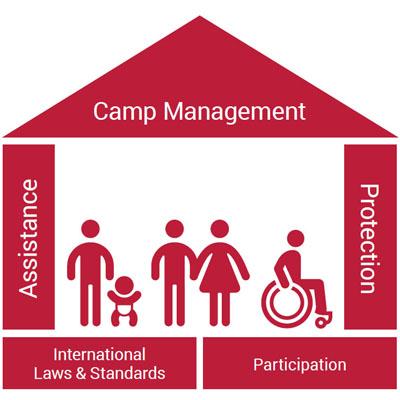Introduction
Whether triggered by an earthquake, flood, tsunami, volcano, drought, civil war, regional conflict or a failed peace accord, emergencies can strike anytime and anywhere. They can rapidly leave people homeless and in need of protection and assistance. For those who have lost property, lived through traumatic events, and are suddenly stranded or displaced outside the safeguards of their own homes and communities, camps can offer a safe haven in which to receive medical treatment, food, shelter, and other basic services. While camps cannot provide permanent sustainable solutions, if they are well-managed, they can temporarily meet the human rights of displaced populations and provide them with temporary refuge.
Last Resort Option
Camps are an option of last resort, sometimes the only choice for the temporary provision of assistance and protection to affected populations forced to flee their home due to natural disaster or conflict. All other support options should be considered before deciding in favour of a camp settlement.
The aim of camp management is to ensure that assistance and protection provided in camps are in line with national and international laws, guidelines and agreed standards. To achieve this, effective camp level coordination between all stakeholders is a central task of every Camp Management Agency. A Camp Management Agency must work with a wide range of camp stakeholders to ensure that the camp population has equitable access to the assistance and services they need.
To some extent, the role of a Camp Management Agency could be compared with that of a municipality, though the formal authority to exert power will usually not be the same. While camp management staff is required to be firm advocates for the human rights of all displaced persons, they must also be diplomatic. The concept of camp management only comes into effects when the various interests and motives of all stakeholders involved in a camp response are understood by the agency in charge.
The ultimate responsibility to provide protection and humanitarian assistance to people in need within its sovereign boundaries lies with the state. The responsibility of the humanitarian community is to support the state if it is unable or unwilling to fulfil its duties.
Regardless of whether it is a national or international non-governmental organisation or national authority who takes responsibility for the camp management the humanitarian principles of humanity, neutrality, impartiality and operational independence represent the ethical foundation for stakeholders carrying out humanitarian work in emergencies (OCHA, June 2012). The four principles are defined as follows:
| Humanitarian Principles |
|---|
|
Humanity |
Neutrality |
Impartiality |
Operational Independence |
|---|---|---|---|
| Human suffering must be addressed wherever it is found. The purpose of humanitarian action is to protect life and health and ensure respect for human beings. | Humanitarian actors must not take sides in hostilities or engage in controversies of a political, racial, religious or ideological nature. | Humanitarian action must be carried out on the basis of need alone, giving priority to the most urgent cases of distress and making no distinction on the basis of nationality, race, gender, religious belief, class or political opinions. | Humanitarian action must be autonomous from the political, economic, military or other objectives that any actor may hold with regard to areas where humanitarian action is being implemented. |
While adherence to these humanitarian principles is the cornerstone of humanitarian response, the Camp Management Agency must also demonstrate accountability in their activities which, by definition, exercise influence and power over the lives of affected persons and communities. Accountability is discussed in detail at the end of this chapter.
A Camp Management Agency typically strives to apply Sphere minimum standards when responding to the humanitarian needs of displaced persons in a camp setting. The Sphere Project standards are based on the belief that persons affected by a crisis have a right to life with dignity and assistance, and that all possible steps must be taken to alleviate human suffering (Sphere, 2011). In the delivery of assistance, the Camp Management Agency also refers to standards used by UNHCR, the International Network for Education in Emergency (INEE), the Livestock Emergency Guidelines and Standards (LEGS), the Minimum Standards for Child Protection in Humanitarian Action and the Inter-Agency Standing Committee (IASC) Guidelines for Gender-based Violence Interventions in Humanitarian Settings.
The Camp Management House provides a visual aid that is frequently used to elaborate how the Camp Management Agency communicates with and coordinates a wide range of actors to ensure the rights of the camp population. Camp management consists of providing assistance and protection to displaced populations living in camps according to the legal protection framework and minimum humanitarian standards, thus ensuring that affected populations participate in camp daily activities. The Camp Management House illustrates that camp management implies an holistic approach and a cross-cutting sector response. Camp management is both technical and social in its aim.

